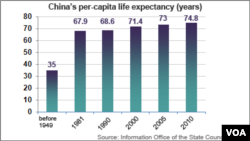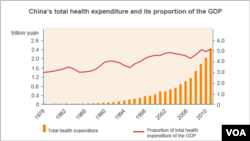China says it has improved the quality health care to its population, but observers say continued reforms are needed to fix a dysfunctional system that is still plagued by high costs and uneven access.
A government white paper released this week says health care reforms launched in 2009 have made medical services more affordable and accessible, and have narrowed a substantial gap between care received in urban and rural regions.
Beijing has set the goal of providing universal health care to all residents, both urban and rural, by 2020. To reach that objective, health care spending is projected to triple to $1 trillion annually by 2020.
The government says its investment in health care is paying off. Ninety-five percent of China's 1.3 billion people are covered by some form of health insurance, making it what the white paper said is the "world's largest network of basic medical security."
"No other country in the world has implemented system-wide reforms so rapidly," says Dr. Michael O'Leary, the World Health Organization's Representative to China. "In other countries, it's taken years to make similar achievements."
Out-of-Pocket Expenses Still High
O'Leary tells VOA he is "greatly impressed" by Beijing's success in providing health coverage to such a large percentage of the population. But he says medical costs are still high, even for the insured.
"The insurance schemes cover a very large percentage of the population, but not at a very deep level," O'Leary says. "So when health care costs are higher, there's still out-of-pocket expenses, and that remains a major challenge."
Observers say out-of-pocket expenses have been devastating for many in rural areas, where a chronic or catastrophic illness can threaten to plunge lower-income residents back into poverty.
Reforms Spread Unevenly
Another challenge is the uneven spread of China's health care reform. Michael Woodhead, a Britain-based medical researcher and author who focuses on China, tells VOA many of China's rural areas are still served by makeshift medical practitioners with little training.
"At the very lowest level, the village level, the health care practitioners are often people who have descended from the 'barefoot doctors.' They don't have medical training, they perhaps have a year in college. And they're often providing all the services for the poorest people in China," says Woodhead.
Woodhead says high drug prices, a lack of qualified doctors and nurses, and an aging population are just a few of the the many problems still facing China as it overhauls its health care system.
China's white paper acknowledges as much, saying that its healthcare undertakings still fall "far short of the public's demands for healthcare as well as the requirements of economic and social development."
But many observers, including Woodhead, agree that, despite the obstacles, China is making steady progress toward providing quality health care for its citizens.
"They are moving in the right direction," says Woodhead. "Trying to turn it around and provide a universal health care system for 1.3 billion people is a huge undertaking."
A government white paper released this week says health care reforms launched in 2009 have made medical services more affordable and accessible, and have narrowed a substantial gap between care received in urban and rural regions.
Beijing has set the goal of providing universal health care to all residents, both urban and rural, by 2020. To reach that objective, health care spending is projected to triple to $1 trillion annually by 2020.
The government says its investment in health care is paying off. Ninety-five percent of China's 1.3 billion people are covered by some form of health insurance, making it what the white paper said is the "world's largest network of basic medical security."
"No other country in the world has implemented system-wide reforms so rapidly," says Dr. Michael O'Leary, the World Health Organization's Representative to China. "In other countries, it's taken years to make similar achievements."
Out-of-Pocket Expenses Still High
O'Leary tells VOA he is "greatly impressed" by Beijing's success in providing health coverage to such a large percentage of the population. But he says medical costs are still high, even for the insured.
"The insurance schemes cover a very large percentage of the population, but not at a very deep level," O'Leary says. "So when health care costs are higher, there's still out-of-pocket expenses, and that remains a major challenge."
Observers say out-of-pocket expenses have been devastating for many in rural areas, where a chronic or catastrophic illness can threaten to plunge lower-income residents back into poverty.
Reforms Spread Unevenly
Another challenge is the uneven spread of China's health care reform. Michael Woodhead, a Britain-based medical researcher and author who focuses on China, tells VOA many of China's rural areas are still served by makeshift medical practitioners with little training.
"At the very lowest level, the village level, the health care practitioners are often people who have descended from the 'barefoot doctors.' They don't have medical training, they perhaps have a year in college. And they're often providing all the services for the poorest people in China," says Woodhead.
Woodhead says high drug prices, a lack of qualified doctors and nurses, and an aging population are just a few of the the many problems still facing China as it overhauls its health care system.
China's white paper acknowledges as much, saying that its healthcare undertakings still fall "far short of the public's demands for healthcare as well as the requirements of economic and social development."
But many observers, including Woodhead, agree that, despite the obstacles, China is making steady progress toward providing quality health care for its citizens.
"They are moving in the right direction," says Woodhead. "Trying to turn it around and provide a universal health care system for 1.3 billion people is a huge undertaking."













